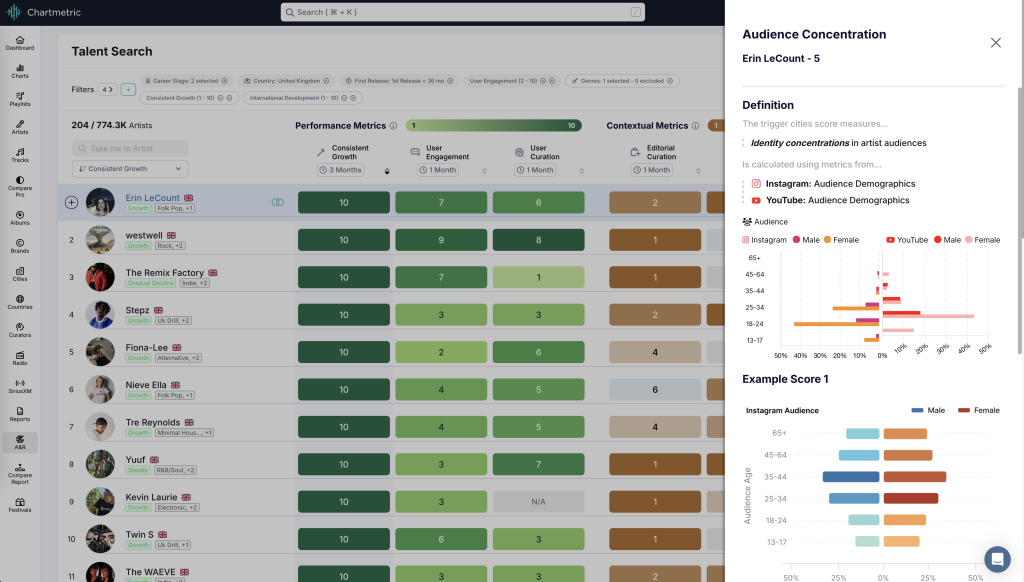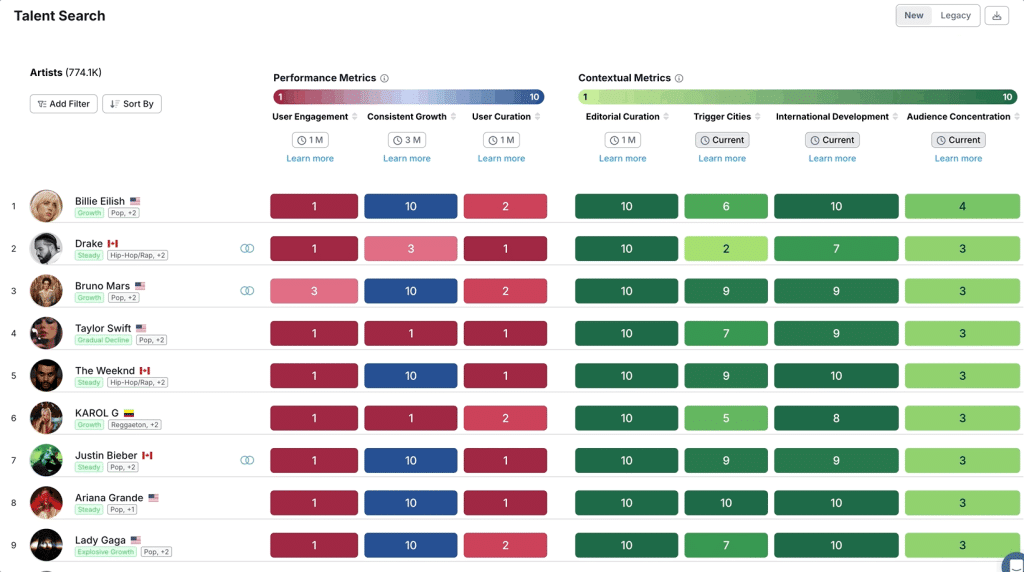Chartmetric’s ‘Talent Search Tool’ sifts through an enormous amount of data to better predict winners (photo: Chartmetric)
You can forgive the music industry for being blasé about the fate of TikTok in the United States.
In fact, many have privately expressed to DMN that they’d love to see TikTok pack its bags. Over the past year, TikTok has done an impressive job of pissing off a vast range of rights owners, from Universal Music Group to the smallest indie. In the blunt language of this business, TikTok’s payouts stink — and so does its attitude towards rights owners.
But there’s a deeper reason why many in the music industry have done little to advocate for TikTok’s survival in the US: it just doesn’t matter as much for their businesses. That came into stark focus with UMG: according to data unearthed by DMN Pro, Universal Music was making more from paid downloads than TikTok royalties before their dispute.
Beyond the financial calculations, there’s an even more serious issue: chasing down viral TikTok artists is becoming a losing game.
“The TikTok gold rush is declining,” Chartmetric analyst Domenico Randazzo told Digital Music News while pointing to more reliable success indicators like Instagram engagement and user-created streaming playlists — among dozens of other data predictors.
Others, including Duetti, are finding that TikTok’s supposed star-making magic only runs so deep. TikTok is undoubtedly breaking new artists and breathing life into old songs, but the success levels aren’t great outside of the flashy outliers. Digging into the data, Duetti found that even amongst the fewer than 1% of tracks that ‘go viral’ on TikTok, only about 15% experience long-term streaming growth on digital service providers (DSPs) like Spotify and Apple Music.
Those stats aren’t shocking for data players like Chartmetric. The company quickly realized that music executives were shifting away from TikTok signing derbies and more towards sophisticated data analytics to identify the next generation of chart toppers. After nearly two years of intensive research, the company recently launched a predictive talent search tool, promising to give companies an edge in the race to identify tomorrow’s superstars.
The company’s new offering, simply called ‘Talent Search Tool,’ sifts through data from over 10 million artists, identifying key “signals” that suggest an artist’s potential for long-term success. Each artist receives a daily score from 1 to 10 across various metrics, making it easier to spot emerging talent worthy of deeper investigation. Just recently, Chartmetric joined forces with DMN to broaden awareness of its data-powered predictive tool.
“Data has always been an essential component of the gut instinct that A&Rs rely on,” says Chaz Jenkins, Chief Commercial Officer of Chartmetric. “But with so many artists releasing music today, it’s nearly impossible for anyone to have sufficient awareness of the marketplace.” In that soup, Chartmetric aims to offer a data-driven lens to navigate the overwhelming volume of music being released globally.
Decoding the Signals: What Makes a Future Star?
Chartmetric’s tool categorizes these signals into Performance Metrics and Contextual Metrics. Performance Metrics, such as user engagement (for example, Instagram likes relative to followers), consistent growth across streaming platforms, and user-created playlist additions, provide quantifiable measures of an artist’s traction.
Contextual Metrics, on the other hand, offer a more nuanced view, considering factors like editorial playlist placements, presence in “trigger cities” (those with high listener growth potential), international reach, and audience demographics.
“There is no single metric that can predict success,” explains Akash Mukherjee, VP of Product Management at Chartmetric. “Each of the signals we identified integrates multiple data points from many services.”
According to Mukherjee, the tool’s power lies in its ability to handle the “heavy analytical work behind the scenes,” allowing users to identify emerging talent far earlier than traditional methods.
Suddenly, Context Is King.
Chartmetric emphasizes that these metrics are not to be interpreted in isolation. Context is crucial. For instance, a low editorial curation score might indicate that an artist is gaining traction purely through organic fan engagement, which could be a valuable asset. “Extreme values provide context about an artist’s profile, not necessarily positive or negative,” notes Randazzo.
The tool’s flexibility is also key. Users can apply filters for genre, region, gender, career stage, and other criteria to narrow their search and find artists who align with their specific goals. This customization is vital in an industry where different stakeholders have varying priorities. Labels may seek rapid growth, while publishers might focus on established, recurring success.
But is Chartmetric simply setting the stage for the next ‘A&R arms race’?
Companies are notorious for glomming around rising TikTok stars with checkbooks in hand. But Chartmetric is hoping to offer something more tailored to what different companies are actually chasing. Chartmetric’s Morgan Burrell told DMN that companies are now racing to “determine specific findings and tailor the tool to individual needs” instead of chasing a single viral sensation.
That said, more sophisticated data could create future signing derbies, particularly around fast-surging artists. But that’s always been part of the business.
Speaking of specialization, Chartmetric also noted that its Talent Search Tool goes beyond record labels and publishers. For example, artist managers can leverage the tool to track their clients’ progress and refine their strategies. Advertisers and marketers can gain insights into audience demographics for targeted campaigns. Even universities and business schools use Chartmetric to train the next generation of music industry professionals.
But great results will probably take some training, particularly for those wanting to find long-term artists who can thrive in their businesses. As for the evolving expertise required to interpret the data, this is about as far from the days of A&R guys hitting clubs and listening to demo tapes as possible.
It’s also a step beyond the madness of chasing TikTok virality. “It’s all about the nuances of interpreting various metrics on the platform,” says Randazzo. “Contextual understanding of these metrics is critical.”


